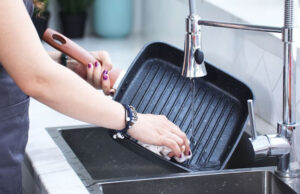One of the initial decisions you make when installing or redecorating your kitchen is the flooring. This choice depends on a number of factors, such as the size of your kitchen, your spending limit, and whether or not you need pet-friendly flooring. Laminate flooring is one of the most common types of flooring, but can and ought it be used in kitchens?
Laminate appears to be a popular choice among homeowners due to its many advantages. Examine this exhaustive list of the advantages and disadvantages of installing laminate in the kitchen before deciding whether it is the best option for you.
Table of Contents
Can You Put Laminate flooring In The Kitchen?
You can install laminate flooring in your kitchens. Because laminate isn’t waterproof, you will need to exercise caution when installing it. To shield the flooring from moisture, the proper vapor barrier underlayment must be installed. Additionally, any spills must be cleaned up right away.
A few things are worth keeping in mind, though, before you decide if this is the best option for you and your kitchen.
Pros Of Laminate In The Kitchen
A Pleasant Look
One of the most adaptable types of flooring for the home is laminate. The availability of laminate in such a wide variety of designs, hues, and patterns contributes to its appeal. The colors of laminate wood are customizable and can mimic the appearance of real hardwood. You can choose from hundreds of different colors to find the perfect match for your house without having to stain your floors the correct shade.
You can choose laminate in both modern and traditional designs. As well as sleek, contemporary-looking laminate planks and tiles, you can also find rustic and aged varieties. Many producers have expanded their product lines beyond faux wood flooring to include a variety of laminate flooring colors, including some that mimic stone and metal. Having a wide variety of aesthetically pleasing options makes it simpler to give your house a makeover that feels individualized, fashionable, and distinctive.
Lower Price
The most appealing quality of laminate, in the eyes of many homeowners, is its reasonable cost. The price of laminate per square foot is frequently as low as $3. This cost is significantly less than many other options for flooring. For instance, if you compare the costs of hardwood and laminate, you will discover that hardwood is up to five times more expensive.
Laminate flooring also provides installation savings. Numerous types don’t need to be nailed, glued, or stapled. As an alternative, the laminate planks or tiles snap together to create a floating floor. In many cases, you can simply install your laminate over the existing floor without making any changes to it. Many homeowners can complete this installation themselves and save tens of thousands of dollars by hiring professionals to install other types of flooring.
It’s Durable And Easy To Maintain
Every laminate flooring piece has a clear wear layer on top. The floors are shielded by this layer from fading, stains, and scratches. Laminate can last quite well, even in areas with a lot of foot traffic (like a kitchen). With no counterpart in other types of floors, the wear layer adds a level of durability.
Your laminate floors’ wear layer also gives them a smooth, hygienic surface. Simply sweeping the floors on a regular basis will keep them clean for homeowners. For a deeper clean, you can occasionally use a damp mop.
Generally Fewer Defects
While doing away with the flaws common to other flooring types, laminate is designed to look as authentic as possible. For instance, it’s possible to occasionally find flooring made of hardwood or natural stone that has unusual color or pattern variations. On the floor, these objects might not look right. Aesthetics must be sacrificed by homeowners, or they must pay more for replacement items that blend in better with the rest of their flooring. Not so with laminate, which offers options for flooring that look like wood and other natural materials.
With laminate flooring, you can get pieces that are just as realistic-looking as the real thing without having to deal with the unusual flaws that some other flooring types can have. Since laminate tile and plank manufacturers can more easily regulate the product quality, the colors and patterns are uniform throughout.
The Cons Of Laminate In The Kitchen
May Occur Moisture Damage
When exposed to moisture for an extended period of time, laminate is vulnerable to damage. You shouldn’t worry if you occasionally spill water or another liquid on the floor. Messes won’t harm your floors as long as you clean them up right away when they happen. Your laminate floor may warp and become stained if moisture remains there for a long time.
Take measures to prevent moisture damage to your laminate floors. Put a rubber mat under pet water bowls and quickly clean up any spills. If you mop your floors, wipe them off with towels after you’re done rather than allowing any moisture to air dry.
Can’t Be Refinished
Your laminate floors can’t be refinished after they start to fade. Instead, you’ll have to get new flooring. Since the flooring is put in place using snap-together tiles or planks, you might want to buy extra pieces that you can only use if specific sections of your kitchen floor begin to deteriorate over time.
There is a benefit to this disadvantage as well. In general, laminate lasts 15 to 25 years. Some laminate floors could maintain their appearance for up to 30 years. If you want your flooring to last for 20 years or more and be in a high-traffic area of the house like the kitchen, look for high-quality laminate.
Eco-friendliness
Laminate might not be the best option for you if you’re determined to renovate your kitchen with environmentally friendly materials. Because the wear layer is made of plastic, laminate flooring doesn’t break down well in landfills. Additionally, some laminate flooring options contain chemicals like formaldehyde in their construction, which can release volatile organic compounds (VOCs). These toxic gases, or VOCs, have the potential to have negative effects on both human health and the environment.
The Environmental Protection Agency (EPA) has updated regulations that demand laminate flooring have less VOC content in recent years. Even though materials with low VOC content are safe to use in your home, they might not be the best choice for the environment as a whole.
Laminate flooring comes in a variety of eco-friendly variations. If you want to laminate with less of an impact on the environment, consider the following factors:
- Pick laminate that has been made from recycled and sustainable materials. The Forest Stewardship Council (FSC) has given its approval to a few types of flooring. Utilizing wood from sustainably managed forests, this type of flooring.
- Identify whether water-based, low-VOC inks were used to print the design.
- Choose laminate that can be installed without the use of glues or adhesives, which may contain volatile organic compounds (VOCs).
Considering laminate as an option for your kitchen may be eliminated after reading this list. On the other hand, it might increase your confidence in laminate as the best material for your house. If you’re deciding whether laminate is the best option for your kitchen, be sure to take your needs and personal spending power into account.
How To Install Laminate In Kitchen?
You must select an underlayment, gather the necessary equipment, and adhere to our step-by-step instructions in order to install laminate in the kitchen:
Choose A Moisture-proof Underlayment
Installing laminate is a fairly easy process. It’s crucial to keep in mind that you’ll also need to install an underlayment layer to shield your floors from moisture. Typically, foam is used because it has sound-muffling properties.
Make sure to select an underlayment that has a vapor barrier attached when making your selection, like the Floorlot Underlayment. Your floor will be protected from moisture by the vapor barrier, and choosing one that is affixed to your underlayment makes installation much simpler.
Tools And Materials To Install Laminate In The Kitchen
- Panel saw
- Knives
- Claw hammer
- Nail setters
- Punches
- Carpenter squares
- Circular saw
- Tape measure
- Level
- Clamps
- Underlayment
- Finishing nails
- Caulk and sealant
Step-by-step Guide
You can begin the installation procedure as soon as you have the underlayment. The steps below should be followed to install laminate flooring:
- Prepare the kitchen. Make sure the subfloor is solid, flat, and free of debris before removing any flooring that may be present. If your vapor barrier and underlayment are two different products, place the vapor barrier first.
- Ensure the door jambs fit. Measure the height of your laminate, then cut the molding to fit. With a jamb saw, cut along the molding’s outline.
- Make a plan. To figure out how wide the last row of planks should be, measure the width of the space. Keep in mind to leave 3/8 inch gaps along both walls to allow for the floors’ normal expansion.
- Cut out the first and last rows according to your measurements. Laminate is challenging to cut through and might harm less durable blades, so I advise using a saw with a diamond blade to do this.
- Install the underlayment. You can skip this step if you are using laminate flooring that already has an attached underlayment. As overlaps will result in bumps under the flooring, make sure the underlayment is flush with one another. To better maintain the vapor barrier and hold the underlayment in place, duct tape the seams.
- Install the first row of planks. As previously stated, leaving 3/8 inch along the wall to allow for natural expansion and contraction. Make sure the tongues are facing the wall when you lay the first row. If at all possible, begin installing on the room’s door side to ensure that the threshold has sharp edges.
- Finish laying the laminate. Install the remaining rows, spacing the seams to add stability and a more natural appearance. To prevent moisture damage, make sure the seams are secure and there are no gaps.
- Install the baseboard, molding, and threshold.
The Best Kitchen Laminate Flooring
Keep in mind, that laminate flooring is not waterproof. There are particular laminates with characteristics that can reduce kitchen accident risk. There are a few factors you should take into account when choosing the best laminate flooring for your kitchen.
- Wax Edges: Wax edges on laminate flooring can help prevent moisture from penetrating the flooring for a longer period of time. This laminate is ideal for use in locations where spills may occur. You have a little longer to clean up the mess if you miss a spot!
- Durability: Pick a laminate floor covering that will last for a long time. For the greatest durability in your home, pick laminate flooring with an AC rating of AC3 or higher. For homes with more traffic, choose a higher AC Rating!
- Color: If you want the rest of your home’s décor to match the laminate flooring. It is entirely up to you whether you want your kitchen to be painted the exact same color as the rest of your house or if you want to use a different color to distinguish it. Because they give the impression of a clean space, white and light-colored flooring is very popular in kitchens. To find out which flooring complements your current floor the best, order several free samples!
- Shape: We advise using planks for your kitchen’s laminate flooring if you want to keep the style of the rest of your house consistent. However, if you want to slightly vary the appearance of your kitchen, you might want to use a square shape to mimic tile flooring.
- Finish: Laminate flooring comes in a variety of matte or glossy wood textures, much like photographs. Pick the finish that you prefer. Both finishes are very strong.


